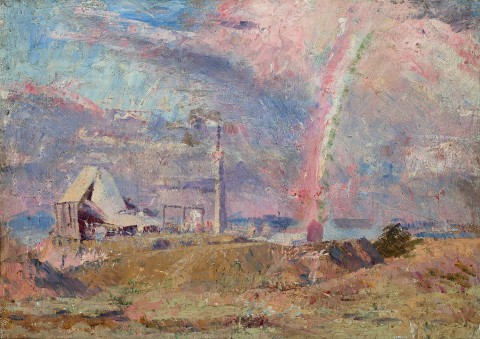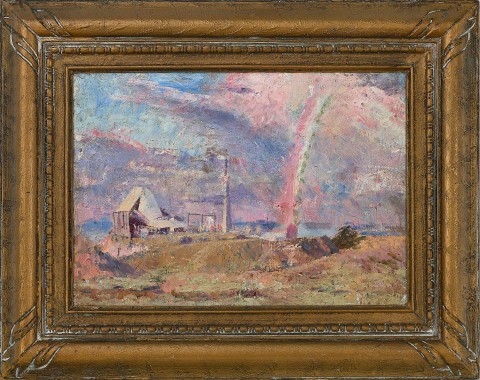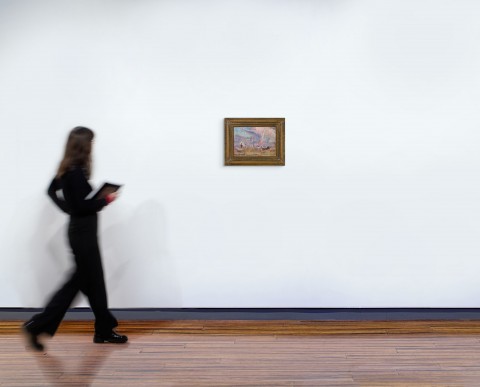RAINBOW OVER BURNLEY, 1910
FREDERICK MCCUBBIN
oil on wood panel
25.0 x 35.5 cm
bears inscription verso: Burnley Quarry / by F McCubbin / 1910
letter of authenticity attached verso, signed by Louis McCubbin, dated 29 June 1949
Sedon Galleries, Melbourne
Dame Elisabeth Murdoch, Cruden Farm, Victoria, acquired in 1949
McClelland Collection, McClelland Sculpture Park and Gallery, Langwarrin, gifted from the above in 1989 (label attached verso)
Exhibition of paintings by the late Fred McCubbin, Sedon Galleries, Melbourne, 2 – 12 August 1949, cat. 21 (as 'The Rainbow')
‘A happy life’: Frederick McCubbin’s small paintings and oil sketches, National Gallery of Victoria touring exhibition; City of Ballarat Fine Art Gallery, Victoria, 30 November 1991 – 12 January 1992, Benalla Art Gallery, Victoria, 1 February – 2 March 1992, City of Hamilton Art Gallery, Victoria, 24 March – 21 April 1992, Mornington Peninsula Arts Centre, Victoria, 8 May – 5 July 1992, Queen Victoria Museum and Art Gallery, Launceston, 23 July – 13 September 1992, and Latrobe Valley Arts Centre, Victoria, 2 – 31 October 1992, cat. 29 (label attached verso)
McCubbin: Last Impressions 1907 – 17, National Gallery of Australia, Canberra, 14 August – 1 November 2009; and touring to Art Gallery of Western Australia, Perth, 12 December 2009 – 28 March 2010, and Bendigo Art Gallery, Victoria, 24 April – 25 July 2010, cat. 31 (label attached verso, as 'The rainbow (Rainbow over Burnley)')
Clark, J., ‘A happy life’: Frederick McCubbin’s small paintings and oil sketches, National Gallery of Victoria, Melbourne, 1991, cat. 29, pp. 11 (illus.), 22
Gray, A., McCubbin: Last Impressions 1907 – 17, National Gallery of Australia, Canberra, 2009, cat. 31, pp. 85, 100 (illus. as 'The rainbow (Rainbow over Burnley)')
Autumn (Stone crusher, Richmond Quarry), 1908, oil on canvas on plywood, 50.5 x 76.0 cm, in the collection of the Tasmanian Museum and Art Gallery, Hobart
The old stone crusher (The quarry), 1911, oil on canvas, 76.0 x 91.5 cm, in the collection of the Art Gallery of South Australia, Adelaide
The stone crusher, c.1912, oil on canvas on board, 25.5 x 35.5 cm, in the collection of the Castlemaine Art Museum, Victoria
For six decades, the bluestone quarries of Richmond provided basalt for building and road construction throughout Melbourne. Located south of Coppin Street in the area known locally as Cremorne, they operated until extensive flooding in 1918 sealed their fate and the resultant lakes were opened to the river, leaving Herring Island their wake. The stone crusher was a centrepiece of the operations, a noisy, smoky machine to most, but to Frederick McCubbin, a wonderful subject which he would paint on a number of occasions from the family home ‘Carlesberg’ situated directly across the Yarra, a ‘charming old colonial house of stone, cool on the hottest days, perched right over the Yarra with three acres of garden and trees.’1 His daughter Kathleen Mangan would later recall how McCubbin ‘loved that old stone crusher, and it was so accessible to painting – looking across from our hill.’2 Rainbow over Burnley, 1910 is a striking study of the crusher, unusual in the fact that McCubbin has now travelled across the river and inspects the machine up close.
The McCubbins had lived at Carlesberg since 1909, two years after the artist’s first and only journey overseas. McCubbin stayed for three months, predominantly in England with shorter visits to France and Italy. He spent much of that time in galleries, intensely studying impressive works by his heroes, particularly JMW Turner, whose paintings had a profound effect on him. Even so, McCubbin wrote in a letter to his colleague Tom Roberts that ‘I actually thought I was somebody over in England, right up against Rembrandt, Turner, Velasquez, Gainsborough, Reynolds. I felt quite in good company.’3 In Rainbow over Burnley Monet is in there too, McCubbin having seen his work in Paris. Further, he stated emphatically that he now did not want to ‘‘arrest Nature’, but rather to emulate the spirit of great landscape masters of the past… whom he felt had ‘caught it alive.’’4 On his return, McCubbin’s painting technique underwent a radical change of direction. In this new approach, as vividly expressed in Rainbow over Burnley, McCubbin built up a rich surface of overlapping paint layers using palette knives and brushes. In some places, he wiped the paint back to reveal the texture of the canvas or wood; in others he left the paint thick or scratched into it using the handle of his paintbrush. ‘By this method the underneath colours would show through the over-paintings, and the effect of transparency and broken colour was accentuated; advantage could also be taken of ‘accident’… [pictures were] painted at concert pitch for themselves.’5
Nature was McCubbin’s supreme entity, but he was fascinated too by humanity’s impact upon it. In Rainbow over Burnley, the stone crusher stands proudly, suddenly graced by the presence of a rainbow, ‘alluding to notions of both the metaphysical and physical.’6 With this painting, as well as related works The old stone crusher (The quarry), 1911 (Art Gallery of South Australia) and The stone crusher, c.1912 (Castlemaine Art Gallery), he gives ‘industry a central place, he transformed and ennobled the building.’7 In 1942, Sir Keith Murdoch opened a memorial exhibition of McCubbin’s paintings, and seven years later, his wife Dame Elisabeth purchased Rainbow over Burnley, later gifting it to the McClelland Sculpture Park and Gallery.8
1. Frederick McCubbin, Letter to Tom Roberts, late December 1907, cited in McKenzie, A., Frederick McCubbin 1855 – 1917: ‘The Proff’ and his art, Mannagum Press, Melbourne, 1990, p. 269
2. McKenzie, ibid., p. 170
3. Frederick McCubbin, Letter to Tom Roberts, 1907, op. cit.
4. Frederick McCubbin, correspondence, 27 January 1909, cited in Clark, J., ‘A happy life’: Frederick McCubbin’s small paintings and oil sketches, National Gallery of Victoria, Melbourne, 1991, p. 6
5. McCubbin, L., Bulletin of the National Gallery of South Australia, Adelaide, vol. V, no.1, July 1943
6. Gray, A. (ed.), McCubbin: Last Impressions 1907 – 17, National Gallery of Australia, Canberra, 2009, p. 100
7. ibid., p. 134
8. See ibid., p. 100
ANDREW GAYNOR


